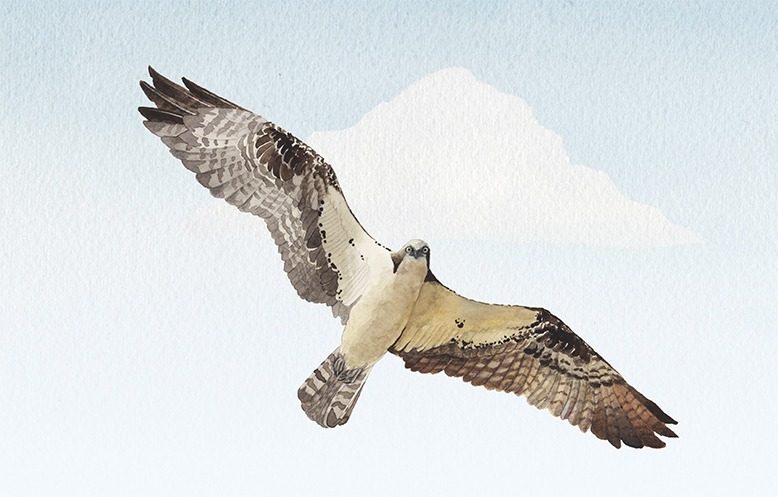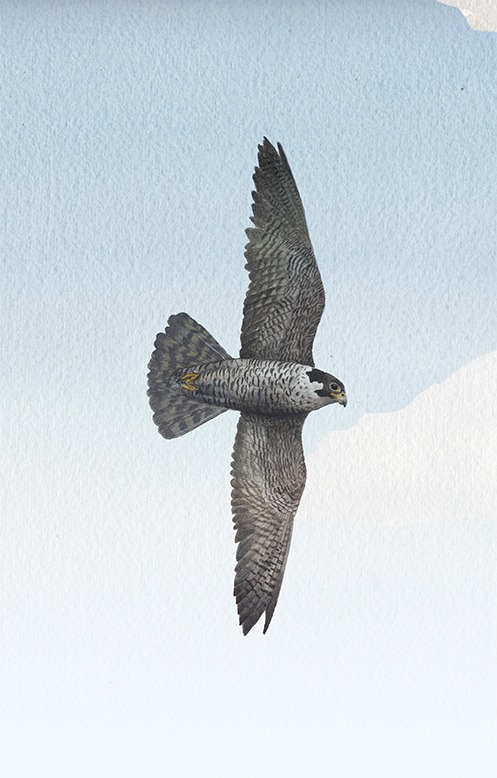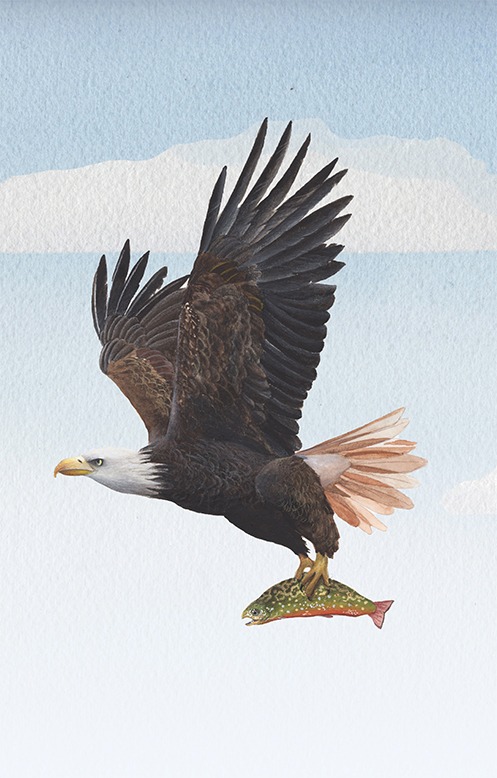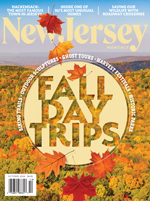
On a circular stone overlook more than 500 feet above the Hudson River, photography buffs point their long lenses north in anticipation of the arrival of avian VIPs. Nearby, observers with binoculars agree to disagree on the identity of a raptor high in the cloudless sky. Meanwhile, a pair of juvenile hawks roughhouse in midair, while a resident peregrine falcon, affectionately known by the regulars as the Beast, perches on a limb jutting from the cliffs.
It’s raptor-migration season—and the passing birds of prey have turned New Jersey’s skies into a hawk highway.
Here on the forested edge of the Palisades cliffs at State Line Lookout in Alpine, Karl Soehnlein of Cresskill scans the skies with binoculars as raptors head south from New England and Canada using a fuel-efficient, avian form of cruise control. With thousands of miles to cover, constant flapping isn’t an option. Instead, they soar, lifted by thermal updrafts created by mountain ridges and other topographic features. The birds rise on the thermals and glide on air currents until they reach their destinations as far away as South America.

Peregrine falcons disappeared from New Jersey in the 1960s, their numbers decimated nationwide by the pesticide DDT. Thanks to conservation efforts, 40 nesting pairs were reported in the state in 2018. Illustration by Emily Renaud
Fall hawk-watching season in New Jersey opens a wide window of opportunity to witness a remarkable natural phenomenon in some of the state’s most stunning settings. From September through November, bird counters eye the skies for funnel-like kettles of hundreds, sometimes thousands, of broad-winged hawks, followed through migration season by ospreys, bald eagles, northern harriers, sharp-shinned hawks, American kestrels, peregrine falcons, merlins, Cooper’s hawks, goshawks and golden eagles. Cold fronts with winds out of the north generally bring the greatest numbers of birds.
Aside from the thrill, counting hawks is about science. Raptors hunt, but aren’t hunted themselves, so high counts indicate a healthy ecosystem with plenty to eat. “When you see an eagle pull a fish from the river and fly around showing it off, you know the river’s doing better,” says Soehnlein, who, like many counters, submits data to the Hawk Migration Association of North America’s database at hawkcount.org.
New Jersey hasn’t always been so sensitive to raptors. A century ago, poultry farmers in southern New Jersey routinely cut down potential nesting trees for eagles. In hawk-shooting galleries in Cape May Point and along the state’s northwestern ridges, sportsmen picked raptors out of the sky.
In fact, raptors were perceived by some as a threat—thanks in part to Thomas Edison, whose eight-minute silent film, Rescued From an Eagle’s Nest, depicted an eagle snatching a hapless child. Edison shot the film in 1907 on the Palisades cliffs, 10 miles south of State Line Lookout.
These days, raptors are no longer harassed. Thanks to conservation efforts, bald eagles, for example, have rebounded in the state from one nest 25 years ago to more than 200 today. “Stick around,” says Soehnlein. “You’ll probably see one.”
State Line Lookout, the highest point on the Palisades, is easily accessible from the Palisades Interstate Parkway (use the unnumbered exit about two miles north of Exit 2). There’s plenty of free parking and a café for snacks. It’s also handicapped accessible. From State Line, you can also take the easy hike to the Women’s Federation Monument, the moderate Peanut Leap Cascade hike, or the challenging Giant Stairs hike.
Soehnlein and other volunteers assist visitors at State Line Lookout from 9 am–5 pm, September 1–November 15. Many visitors, says Soehnlein, come with little knowledge. “Usually, there are turkey vultures flying around, and people will say, ‘Look at the eagles’ or ‘look at the hawks.’ So we correct them and say, ‘This is what they are, and this is what they do.’”
He is often asked how he knows he’s not counting the same bird twice.
“We look for attitude and altitude,” says Soehnlein, who moderates the State Line Hawk Watch Facebook page. That means they count the birds that are flying high and heading southwest.
[RELATED: So, What Is Forest Bathing Anyway?]
The additional watches described below range from steps from your car to an hour’s hike. Some watches are more frequently manned with counters than others. Check websites where listed for possible coronavirus-related closings or limitations.
Whichever watch you choose, you’ll likely want to return each fall. You might even get to know the regulars—including the resident raptors.

Illustration by Emily Renaud
Cape May Point State Park
Light House Avenue, Cape May Point
♦ September 1–November 30, sunrise to one hour before sunset; a counter is present daily.
♦ Features: disabled accessible; restrooms; welcome center; free parking.
Full-time counter Jesse Amesbury stands on the large, elevated platform overlooking Shallow Pond and acres of wetland and forest just off the beach at Cape May Point State Park, which, on one Saturday last October following a cold front drew 1,100 visitors.
“In Cape May, you never know what you’ll see,” says Amesbury, citing the day he counted 2,700 raptors, and another when he saw a Cassin’s kingbird. It was, he says, “the first time one has been seen in New Jersey.” (In September and October, Amesbury is joined by two naturalists who answer questions and lend optics.)
From the watch, walk across the lot to the welcome center for information on guided walks. You can also visit the 157-foot Cape May Lighthouse and the nearby WWII Lookout Tower.
Grab a trail map and enjoy the wheelchair-accessible half-mile Duck Pond loop as it winds through the tall reeds past wintering ducks on Lighthouse Pond. Wander past black gum trees, eastern red cedar, bayberry and holly trees on the 1.2-mile Monarch Trail or the 1.5-mile Plover Trail, both of which lead to the beach, where a walk south past a World War II bunker returns you to the lot.

Bald eagle Illustration by Emily Renaud
Scott’s Mountain Hawkwatch
Merrill Creek Reservoir, Fox Farm Road, Washington (Warren County)
♦ September 1–November 30, 9 am–5 pm; counters are present daily.
♦ Features: wheelchair accessible; restrooms; visitor center; free parking.
Before heading to this laid-back watch with its breathtaking views of the Delaware River Valley, stop at Merrill Creek Visitor Center (34 Merrill Creek Road), an impressive facility with staff, restrooms, and kid-friendly, interactive wildlife exhibits (fascinating for adults, too). if you feel like stretching your legs, grab a map of the six loop trails on the 290-acre preserve surrounding the 650-acre reservoir. Five hikes—from a half-mile path through an old apple orchard to a 2-mile trek along the shoreline—bring you back to the visitor center, where you can picnic or head to the watch, a 2.5-mile drive around the preserve at the Inlet/Outlet Tower parking lot on Fox Farm Road. You also can hike to the watch on the 5.5-mile loop trail from the visitor center.
If you park at the watch, you’ll see that the lot and the watch are one and the same. Here, visitors relax on portable chairs beside their cars; others relax on the park’s north-facing benches. Counters provide binoculars as well as spice cookies. There are few raptors about on this sunny, cloudless day, but a bald eagle sighting makes the visit worthwhile.
“A lot of people have never seen a bald eagle in the wild,” says Dave Dean, a counter from Chester. “One Saturday, we saw over 30. People were in awe. Someone would tap their husband or kid and point at the eagle, amazed they were looking at our national bird.”
Wildcat Ridge Hawkwatch
195 Upper Hibernia Road, Rockaway
♦ August 15–November 15; manned sporadically, but generally weekends, 9 am–6 pm.
♦ Features: bench; kiosk; small gravel parking lot near trailhead; no restrooms.
With views of the New York City skyline some 30 miles away, Wildcat Ridge is a popular destination for birders and hikers. “On weekends later in the season, it’s not unusual to get over 100 visitors,” says Michael Leone of Rockaway Township, who mans the watch on most weekends with his wife, Nora. “About half come for hawk watching, and many are repeat visitors; the rest are hikers passing by.”
Pressed for time, I parked at the end of Upper Hibernia Road near the brown Wildcat Ridge WMA Hawkwatch sign and walked a mile on the wide, gravel Tower Road. For a woodsier option, take the orange-blazed Flyway Trail, which runs through the forest parallel to Tower Road.
Those looking to make a day of it can pick up lunch in Hibernia and hike three miles to the watch on the white-blazed Four Birds Trail, which starts at Green Pond Road in Hibernia and winds past remnants of old mines and the state’s largest bat hibernaculum, as well as boggy areas and deciduous forest. The trailhead is at a gravel parking area on Lower Hibernia Road a short distance from its intersection with Green Pond Road (Route 513).
Raccoon Ridge
Delaware Water Gap National Recreation Area, Blairstown
♦ September–November; manned most weekends.
♦ Features: Parking at Mohican Outdoor Center; no restrooms on trail.
It’s a moderately difficult, rocky hike via 2.5 miles of the white-blazed Appalachian Trail to the peak of Kittatinny Mountain, but the 360-degree view at the ridgetop is fantastic. Add a cold front and northwesterly winds, and you have a recipe for a great number of raptors seen at eye level. “We make sure to cover the watch on every cold front that passes through with northwest winds,” says head counter Jim Thomson of Mount Bethel, Pennsylvania. “When people who know hawks and migration want to see their golden eagle for the season, they come on those days in mid-October through November.”
The Appalachian Trail crosses Camp Mohican Road just before you reach the Mohican Outdoor Center (50 Camp Mohican Road, Blairstown). Park on the shoulder or at the center, where maps, books and facilities are available. Head south on the trail; after entering, cross a small footbridge and follow the white trail marker on the left.



